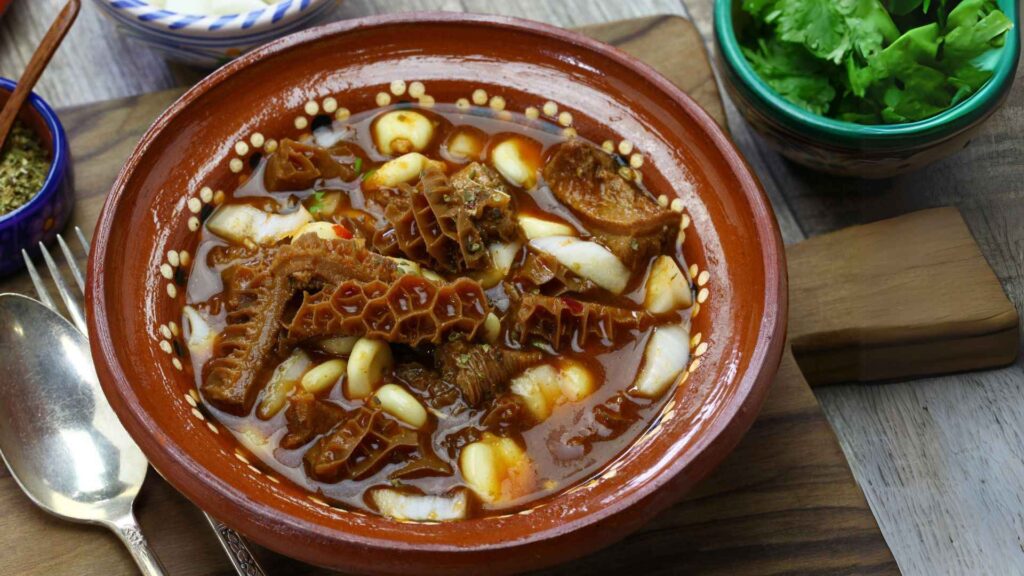
Menudo, a traditional Mexican soup, with moderate GI value can be enjoyed by diabetic individuals when taken in a moderate amount and as a part of a balanced diet.
Menudo offers proteins and cultural significance, its impact on blood glucose levels depends on several factors including portion size, carbohydrate content, and overall dietary choices.
To recognize the potential benefits and negatives of menudo for diabetics it is important to know all the details of its nutritional composition. By carefully examining the ingredients, preparation methods, and portion sizes one can make an informed decision about incorporating menudo in their meal.
Is Turkey Chili Good For Diabetics?
BEST DIABETIC AIR FRYER COOKBOOK
2. Understanding Menudo:

Menudo is an energetic soup typically made of tripe (cow’s stomach lining), hominy, and flavorful broth. While menudo is known for its rich cultural experience its nutritional profile is crucial for diabetic individuals.
3. Nutritional Breakdown

- Protein: Protein is necessary for muscle repair and overall health and menudo is a good source for it. However, the type of protein and preparation method influences its impact on blood sugar levels.
- Carbohydrates: Hominy is the primary source of carbohydrate in menudo which has moderate GI. The carbohydrate content and glycemic index value vary depending on preparation methods so opt for recipes with low amounts of hominy or consider it pairing with non-starchy vegetables to balance the meal.
- Fat: The fat content in the menudo is low but it depends upon the type of meat used and the cooking method. The high fat content will impact the blood glucose level and overall heart health. It is generally recommended to go for leaner cuts of meat and a cooking method that minimizes the fat content to improve the overall nutritional profile of the dish.
4. Menudo and Blood Sugar Management

To manage blood sugar levels it is important to note that recent research represents a mixed picture about menudo. Some studies show that consuming menudo can cause moderate blood sugar spikes due to its carbohydrate content and moderate GI value. However, to enjoy menudo, the following factors should be considered:
- Individual Variability: Each person reacts differently to food and factors like overall health, lifestyle, and daily activities play a major role. So consuming menudo monitor your blood glucose level to assess the impact on your specific condition.
- Preparation Methods: Simmering is the process by which heat breaks down the complex carbohydrate into simpler so simmering for a longer period can potentially impact the glycemic index.
- Portion Control: As discussed earlier moderation is the key while consuming menudo. Smaller portions can help to manage carbs intake and prevent blood glucose spikes.
4.1 Glycemic Index and Fiber Factor:
- Glycemic Index: The glycemic index (GI) of menudo is estimated to be moderate which means it can spike the blood glucose level moderately. However, factors like preparation method, portion size, and individual factors can vary.
- Dietary Fiber: Menudo also contains some amount of dietary fiber, which is why the GI of the menudo is moderate by slowing down digestion and so the blood sugar spike. However, the amount of fiber varies depending on the recipe and ingredients used.
Remember, this information is only for educational purposes only and does not substitute medical advice. It is crucial to consult with your healthcare professional or registered dietitian to incorporate menudo in your diabetes management plan while considering your individual needs and health status.
5. Creating a Diabetes-Friendly Menudo
If you have decided to include menudo in your diabetes management plan consider the following tips:
- Leaner meat: Always go for leaner beef and trim off any visible fats.
- Vegetable Boost: Opt for vegetables that are non-starchy like onion, carrots, and peppers which increase the fiber content and reduce the overall glycemic index value.
- Portion Control: Portion sizes are crucial so be mindful about portion sizes and couple menudo with low carbs side dish.
- Blood Sugar Monitoring: The response of individuals to menudo varies from individual to individual so monitor your glucose level before and after taking menudo to assess its impact on your condition.
Delicious Menudo Recipes for Diabetes:
5.1 Vegan Menudo

Yields: 8
rep time: 30 minutes
Cook time: 40 minutes
5.1.1 Ingredients:
For the soup:
- 3-4 dried snow mushrooms
- 6 sliced shiitake mushrooms
- 1 cup soya (optional)
- 4 cups hominy
- 3 dried California chilies
- 4 dried Guajillo chilies
- 3 large tomatoes
- 1/2 white onion
- 2 garlic cloves
- 1 bay leaf
- 6-8 cups vegetable broth
- 1-2 tablespoons avocado oil
- Salt to taste (about 2 teaspoons)
For serving:
- 1/2 diced purple onion
- 1/4 cup oregano
- 4-5 limes
- Tortilla chips or tostadas
- 1/4 cup minced cilantro
5.1.2 Instructions:
- Prepare the dried chilies: Take the dried chilies and remove stems, seeds, and veins from them. After that soak it with snow mushroom in boiling water for 30 minutes.
- Roast vegetables: Roast the vegetables i.e. tomatoes, garlic, and half onion on a grill for 10-15 minutes over medium-high heat until they become charred. Otherwise, air fry these vegetables at 400°F for 10-12 minutes. Remove the garlic at 7-8 minutes.
- Blend chili base: Drain the chilies from the soaked water and save the soaked water. Now blend the soaked chilies, roasted tomatoes, onion, garlic, and 1 cup of chili-soaked water until smooth. Then strain and set aside.
- Cook the mushrooms: chop the snow mushrooms into bite-sized cubes along with shiitake mushrooms. In a pot, heat the oil over medium heat and add all the chopped mushrooms, and sauté it until about 5 minutes until it becomes golden brown. After that add the chili sauce and simmer for 5 minutes.
- Combine ingredients: The next step is to add vegetable broth, soya, bay leaf, hominy, salt, and mushroom mixture to a pot. And let simmer it for at least 10 minutes.
- Serve: serve in bowls and top it with onion, oregano, lime, cilantro, and tortilla chips or tostadas.
The leftover soup can be stored in an airtight container in a refrigerator for up to 3 days. Reheat in the microwave.
Source: https://healthysimpleyum.com/menudo/
5.2 Low Carb Menudo Blanco | Keto & Diabetic Friendly
5.2.1 Ingredients:
- Cow’s feet, cut into small pieces
- Beef bones
- Onion
- Garlic
- Beef tendon (4 pieces)
- Beef tripe
- Beef book tripe (librito in Spanish)
- Red onion (for garnish)
- Cilantro (for garnish)
- Cabbage (for garnish)
- Lime
- Chiltepin peppers (for garnish)
- Chile guajillo (9 pieces)
- Chile de árbol (5 pieces)
- Salt (to taste)
- Beef bouillon cubes (3)
- Oregano (1 teaspoon)
- Optional: hot soup for blending the chilies
Instructions:
- Prepare the Broth:
- Take a large pot and add cow’s feet, beef bones, onion, and garlic in it. Allow them to cook for 2-3 hours until they become tender.
- Now cut the beef tendon into small pieces and add them to the pot.
- Prepare the beef book tripe by cutting them into small squares and adding them to the pot as well.
- For flavor add additional beef bones.
- Prepare the Garnishes:
- Shred the cabbage finely, chop the red onion, and cilantro, and then slice the lime.
- Optionally prepare the chiltepin for garnish.
- Prepare the Red Chili Sauce (Optional for those who prefer red menudo):
- Now in a blender add 9 chile guajillos, 5 chile de árbol, a teaspoon of salt, and some hot soup from the pot and blend them until they become smooth.
- After that pour the chili sauce into a small pot and simmer for a few minutes. Add a little garlic if desired.
- Season the Broth:
- After cooking, remove the excess fat and impurities from the broth.
- Add 3 beef bouillon cubes, a teaspoon of salt, and a teaspoon of oregano to the pot.
- After doing this now remove the large bones from the broth.
- Combine tripe and Cook:
- After preparing the broth now add the tripe to it and cook it for 40 minutes until the flavor meld together and the tripe becomes tender.
- Optionally, you can add hominy if desired but keep it minimal to control carbohydrate content.
- Serve:
- Garnish the hot menudo with red onion, cilantro, cabbage, lime juice, and chiltepin peppers and serve it.
- For those who prefer red menudo, add the prepared red chili sauce for individual servings.
- Enjoy:
- Enjoy your delicious and nutritional low-card menudo, keeping your diabetes in control or those who are following a keto diet.
This recipe yields a delicious keto-friendly white menudo, perfect for individuals with diabetes or following a low-carb diet. Enjoy the flavorful and comforting dish without worrying about excessive carbs.
Conclusion:
So we concluded that menudo, a traditional Mexican soup can be incorporated into a diabetes-friendly diet when consumed mindfully. This can be achieved by understanding the nutritional composition of menudo and making informed choices, one with diabetes can enjoy this dish while managing their diabetes.
The key for diabetics to enjoy this dish lies in portion control, ingredient selection, and regular blood sugar monitoring.
The impact of menudo on blood glucose levels varies based on individual factors and preparation methods. It is essential to opt for lean protein sources, add plenty of non-starchy vegetables, and maintain a balanced diet overall.
Will you consider adding Menudo to your diabetes management plan?
Frequently Asked Questions (FAQs): Is Menudo good for diabetes?
Is Menudo Safe for Diabetics?
Menudo, a traditional Mexican soup, can be a part of a diabetic diet when consumed in moderation. However, it’s crucial to consider individual dietary restrictions and consult with a healthcare professional for personalized advice.
Can I completely avoid menudo if I have diabetes?
Not necessarily! While understanding the potential impact of menudo on blood glucose level one can add menudo to its diabetic meal plan. Consulting with a healthcare professional or registered dietitian can help you prioritize your health goals while consuming menudo.
What factors influence the impact of menudo on blood sugar?
The following are some factors influencing blood sugar:
- Individual variability: each individual responds differently to food based on factors like overall health and activity level.
- Portion size: A smaller portion size is key while consuming menudo.
- Ingredients: Leaner cuts of meat and low-glycemic options like vegetables along with hominy make the difference.
What Are the Alternatives for Diabetic-Friendly Menudo?
For those seeking diabetic-friendly alternatives, consider using lean meats, such as chicken or turkey, and incorporating a variety of non-starchy vegetables. Additionally, using whole grains or legumes as a base can enhance the nutritional profile while catering to dietary needs.
How Often Can Diabetics Consume Menudo?
Menudo can be enjoyed occasionally and is not a part of a permanent diet plan. It is best to consult with a registered dietitian for a long-term meal plan.
Should Diabetic Individuals Avoid Certain Menudo Ingredients?
Yes, diabetics should be curious about some ingredients like saturated fats, such as fatty cuts of meat and excessive use of oil. Also, it is crucial to monitor the sodium intake to manage blood pressure. Modifying the menudo recipe with leaner cuts of meat, non-starchy vegetables, and healthy ingredients can contribute to a more diabetes-friendly dish.
Sources:
https://www.youtube.com/watch?v=EdJ07LppR6o
https://deliastamales.com/restaurant-delights/menudo-so-good-its-only-sold-on-weekends/





